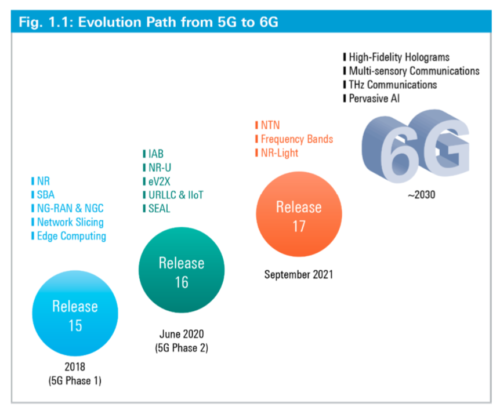According to a new white paper issued by Rohde & Schwarz, the world around us will be significantly shaped by the upcoming enhancements in wireless communications. “Be prepared to be amazed,” is their prediction for the 5G and 6G future. While Release 16 and beyond for 5G has immense untapped potential, 6G will take the user experience to a whole new level and would revolutionize many industries.
Data rates on the order of Terabits-per-second, latency on the order of a few microseconds, and high energy efficiencies for the devices and the network would be hallmarks of 6G. High-fidelity holographic communications and multi-sensory communications could become part of our daily lives. While industries such as healthcare, manufacturing, entertainment, and transportation would begin to be influenced by 5G, they would be transformed on a larger scale by 6G.
To Rohde & Schwarz, 5G Phase 1, or Release 15, provides a strong foundation for enhancements in future releases by defining a high-performance NR air interface and flexible network architecture. Releases 16 and beyond focus on new verticals to significantly expand the applications of wireless communications. Such trends as the ‘support for verticals’ is expected to accelerate in 6G.
Other sections in the study include:
- Service Expansion Beyond Release 15
- 3NR Enhancements Beyond Release 15
- 5G Network Architecture Enhancements
- Predicting the 6G Future
Going beyond the eMBB-centric R15, R16 and later releases expand the supported services, the paper states. 5G LAN can replace or augment fixed or wireless LAN and provide flexibility and enhanced performance. In Non Terrestrial Networks, satellites use 5G to provide service ubiquity, service continuity, and service scalability. Critical Medical Applications benefit from the 5G performance to improve healthcare and to reduce costs. 5G enables new V2X use cases such as platooning, advanced driving, and remote driving. 5G-based UAVs can support a variety of scenarios including the delivery of medical supplies in disaster situations. 5G facilitates Audio-Visual Production Service inside and outside studios. Cyber-Physical Control Applications can exploit 5G to make Industry 4.0 a reality on a large scale. NR-based positioning supports numerous use cases including emergency situations, UAV operations and AR/VR/XR, and factory automation. Haptic communications takes the user experience to a new level by exploiting the haptic sense.
NR undergoes numerous enhancements beyond Release 16. NR-U utilizes NR in unlicensed spectrum and supports a variety of scenarios including Carrier Aggregation and Dual Connectivity. IAB enables the use of spectrum for backhaul in addition to traditional access to reduce deployment costs and simplify radio-core connectivity.
URLLC-centric enhancements include increased reliability, faster processing, more flexible HARQ, uplink cancellation, and enhanced uplink power control. Industrial IoT related NR enhancements include support for TSN reference times and Ethernet and flexible grants and scheduling. New frequency bands between 7 and 24 GHz and above 53 GHz open up more spectrum for numerous use cases including densification, Industrial IoT, backhaul and fronthaul, and ITS. NR also makes enhancements related to MIMO, mobility, positioning, and UE power savings.
Download the full white paper here.
December 13, 2019




Reader Interactions